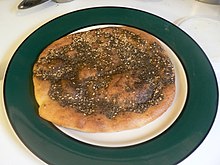User:Bshore1999/sandbox
 Manakish made with za'atar | |
| Alternative names | Manaqish, manaeesh, manakeesh, manooshe, man'ousheh, mankousheh |
|---|---|
| Type | Flatbread |
| Course | Breakfast or lunch |
| Place of origin | Levant |
| Main ingredients | Dough, thyme, cheese or ground meat |

Manakish(Arabic: مناقيش, romanized: manāqīsh) or in singular form man'ousheh, or other spellings, sometimes called Arabic: فَطَايِر, romanized: faṭāyir, is a popular Levantine food[1]consisting of dough topped with thyme, cheese, or ground meat. Similar to a pizza, it can be sliced or folded, and it can be served either for breakfast or lunch. The word manaqishis the plural of the Arabic word manqūshah(from the root verb naqasha'to sculpt, carve out' or engrave), meaning that after the dough has been rolled flat, it is pressed by the fingertips to create little dips for the topping to lie in.[2]
Traditionally, women would bake dough in a communal oven in the morning, to provide their family with their daily bread needs, and would prepare smaller portions of dough with different toppings for breakfast at this time.[3]
Manakish are popular across the Levant,[4][5]and can also be found in neighboring regions, and centers of Levantine emigration.
Classic toppings[edit]
- Za'atar(Arabic: زَعْتَر, romanized: zaʿtar, lit. 'thyme'). The most popular form of manakish uses za'atar(ground dried thyme, oregano, marjoramor some combination thereof, mixed with toasted sesameseeds, salt, and other spices such as sumac) as a topping[6]. The za'atar is mixed with olive oil and spread onto the dough before being baked in the oven. Za'atar manakish is a breakfast favorite in Levantine cuisine.[7][8]It is also served as part of a mezze, or as a snack with a glass of mint tea and feta cheese on the side.[7]
- Cheese(Arabic: جُبْنَة, romanized: jubna). There are two main types of cheese used on manakish: Akkawi(Arabic: عَكَّاوي, romanized: ʿakkāwī) and Kashkaval(Arabic: قَشْقَوَان, romanized: qašqawān). A third cheese: Sfatit(Hebrew:צפתית) is used only in Israel. Za'ataris occasionally added to cheesemanakish to enhance its flavor.
- Minced lamb(Arabic: لحم بعجين, romanized: lāḥm bi-‘ajīn, lit. 'meat with dough') also called Sfiha. Manakish topped with lambare served for lunch due to their heavier contents. The mincedlamb is mixed with tiny pieces of diced tomato and vegetable oil, and the manakish is optionally served with ground pepper or pickles and yogurt.
- Chili(Arabic: فليفلةor فلفل حر).
- Kishq(Arabic: كشك) fermented dried yogurt and finely ground wheat mixture, can be used by itself or in combination with other toppings.
- Spinach(Arabic: سبانخ, romanized: sabāniḵ), Swiss chard(Arabic: سلق).
 | This is a user sandbox of Bshore1999. You can use it for testing or practicing edits. This is not the sandbox where you should draft your assigned article for a dashboard.wikiedu.org course. To find the right sandbox for your assignment, visit your Dashboard course page and follow the Sandbox Draft link for your assigned article in the My Articles section. |
- ^ Specter, Michael (2 May 2016). "The Eternal Magic of Beirut". The New York Times. ISSN 0362-4331. Retrieved 2019-05-09 – via NYTimes.com.
- ^ Massaad, Barbara Abdeni (19 November 2019). Man'oushé : inside the Lebanese street corner bakery (First American ed.). Northampton, Massachussetts. ISBN 978-1-62371-932-6. OCLC 1148154883.
{{cite book}}: CS1 maint: location missing publisher (link) - ^ Riolo, Amy (2007). Arabian Delights: Recipes & Princely Entertaining Ideas from the Arabian Peninsula (Illustrated ed.). Capital Books. p. 107. ISBN 9781933102559.
- ^ "Tayba: Bite-size savory delicacies". Arab News. 25 March 2014. Retrieved 2019-05-09.
- ^ Irving, John (2006). Terra Madre: 1,600 Food Communities. Slow Food Editore. ISBN 9788884991188 – via Google Books.
- ^ Bender, David (2009). A Dictionary of Food and Nutrition. Oxford University Press. ISBN 9780199234875.
- ^ a b Wright, Clifford A. (2003). Little foods of the Mediterranean: 500 fabulous recipes for antipasti, tapas, hors d'oeuvre, meze, and more (Illustrated ed.). Harvard Common Press. p. 310. ISBN 9781558322271.
- ^ Carter, Terry; Dunston, Lara; Humphreys, Andrew (2004). Syria & Lebanon (2nd, illustrated ed.). Lonely Planet. p. 68. ISBN 9781864503333.
manaeesh.
